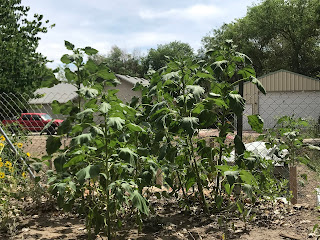This year I have really fallen in love with sunflowers. I
have always liked them, but this year, I am in love. I love them because of
their cheerful disposition, because they are so dang easy to grow, and even
more because they are such great plants for the habitat garden.
 |
| Wild sunflowers in my garden (Helianthus annuus) |
Sunflowers lure pollinators in with their tall form and bright-colored flowers and then they reward them with abundant sources of both pollen and nectar. Both smaller bees and butterflies
find an easy perch on their wide flat heads. Bees that are attracted to
sunflowers include bumble bee, digger bee, large carpenter bee, small carpenter
bee, leafcutter bee, sweat bee, plasterer bee, andrenid (miner) bee, and honey
bees. Even the leaves of sunflower are a good source of food for a variety of butterfly
caterpillars including American Lady, Silvery Checkerspot, and Gorgone
Checkerspot. Later, the black, oily seeds provide food for a variety of birds
such as finches, juncos, and chickadees.
Make sure to save a few seeds yourself to plant for next year.
Another reason to like sunflowers is to provide quick screening
from neighbors. If you have planted a
slower-growing shrub or vine to block a view, but want more instant results,
plant some of the larger sunflowers. Some of the ones in my garden are already
7 feet tall at the end of June!
 |
| Sunflowers (not yet in bloom) blocking the view of my neighbors while my apache plume shrub grows in |
You can also use sunflowers to create a hidden, shady fort for children to play in.
 |
| Sunflower fort - picture from Pinterest |
Some tips for growing sunflowers:
Plant in full sun.
Sunflowers, especially the wild-type sunflower, are drought tolerant, but
will bloom better and grow taller with some water. That said, I am astonished at how well the
wild sunflowers are flowering here in our extreme drought and heat this summer.
Plant in groups to make it easy on pollinators to forage
efficiently. Don’t buy pollen-less
single-stem varieties -- these are good for the cut-flower industry, but bad
for pollinators. Branched sunflowers are
a much better bet, plus produce more blooms for you to enjoy.
Plant several different varieties to provide a continuous
supply of flowers from late summer to fall. Look for “days to bloom” on the
back of seed packets and plant a variety. As a gardener, you can revel in colors ranging
from yellows to oranges to reds, with wildly different sizes of plants and flowers.
You can also sow sunflowers every couple of weeks in the spring to increase
bloom time.
 |
| One of the many varieties of sunflowers you can grow - this just bloomed in my garden yesterday |










